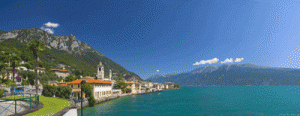Gargnano is a municipality with a vast territory that stretches from the shores of Lake Garda to the reliefs of the inland, going from a typically lake landscape to a mountainous one. Its hamlets are scattered over the vast territory, partly on the coast that overlooks Gargnano, Villa and Bogliaco, and partly on the plateau. The small village is very characteristic; a tale of friar Jodoco da Berga said to be, with Limone, a son of the god Benaco, its appearance is defined by a small harbour, by the narrow lanes marked off by the old orangeries, by the atmosphere of a small village of agricultural origins but with remarkable artistic heritage, where important figures of the past had lived.

TERRITORY OF GARGNANO
Province: Brescia
Fractions: Bogliaco, Costa, Fornico, Formaga, Liano, Musaga, Muslone, Navazzo, Sasso, Villa, Villavetro, Zuino
Surrounding municipalities: Capovalle, Tignale, Toscolano-Maderno, Valvestino, Vobarno
Altitude: 98 m s.l.m. – Population: 3.279 – Inhabitants name: Gargnanesi
Fractions: Bogliaco, Costa, Fornico, Formaga, Liano, Musaga, Muslone, Navazzo, Sasso, Villa, Villavetro, Zuino
Surrounding municipalities: Capovalle, Tignale, Toscolano-Maderno, Valvestino, Vobarno
Altitude: 98 m s.l.m. – Population: 3.279 – Inhabitants name: Gargnanesi
The municipality of Gargnano is one of the most geographically extensive but low population density, being distributed in twelve fractions ranging from the capital, Villa and Bogliaco on the coast Villavetro, Fornico, Zuino on the ridge of the mountain and Navazzo Gargnano, Formaga, Liano , Sasso, Costa Musaga and final plateau of the mountain apart is the fraction of Muslone, overlooking the lake. Its territory extends into the Alto Garda Bresciano Park and includes almost all of the artificial lake of Valvestino, then passing by the typical landscape of Lake Garda in the foothills.
HISTORY OF GARGNANO
Gargnano is mentioned in a document of 937 (Garniano), perhaps as derived from the name of a person, some documents and inscriptions testify to the presence in the town of diverse populations, the Etruscans, the Celts, the Gauls and the Romans. From the middle of the fourteenth century it was under the dominion of the Visconti until the fifteenth, then passed under the Serenissima. Gargnano lived a prosperous time in its history when, in the second half of the nineteenth century, it was made up of farmers and landowners now “Lago di Garda”, with the aim of co-operation for the production and sale of local products (lemons, oil and bay leaf) that they were having on the market an international success. This successful period came to an end with the onset of a disease of lemon trees (gum) which decimated almost all the plantations in conjunction with the new production of citric acid by chemical methods and the arrival of lemons from southern Italy and laurel oil not enough to keep the company alive. Important moments in the history of the country was in October 1943 when it was founded by Benito Mussolini’s Italian Social Republic (RSI) between the towns of Salò and Gargnano, taking place in the various administrative offices and settling with his family in Villa Feltrinelli; were then set up factories for the production of weapons through tunnels to Limone (within Germany) and a track of ‘landing in the town of Bogliaco.
